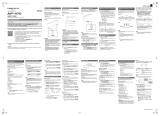
EN-2
Contents
General Guide .................................EN-4
FUNCTION Button......................................................... EN-5
Saving Settings and Using Operation Lock................... EN-5
Power Outlet....................................EN-6
Turning Power On or Off ............................................... EN-6
Returning the Digital Piano to Its Factory Default
Settings.......................................................................... EN-6
Playing with Different Tones .........EN-7
Selecting and Playing a Tone........................................ EN-7
Adjusting Acoustic Piano Sound Characteristics........... EN-9
Layering Two Tones...................................................... EN-9
Using Effects ............................................................... EN-10
Using the Digital Piano’s Pedals.................................. EN-11
Using the Metronome .................................................. EN-12
Playing a Piano Duet................................................... EN-13
Using Built-in Songs
(Concert Play, Music Library,
Demo Tunes) .................................EN-15
Performing Demo Play ................................................ EN-15
Concert Play................................................................ EN-16
Practicing with a Concert Play Song ........................... EN-16
Music Library ............................................................... EN-18
Playing Back a Specific Music Library Song ............... EN-18
Practicing with a Music Library Song........................... EN-18
Playing Back Audio Data Stored on
a USB Flash Drive ....................................................... EN-19
Recording and Playback ..............EN-20
Recording to Built-in Song Memory
(Song Recorder).......................................................... EN-20
Using the SONG RECORDER Button......................... EN-21
Recording to a USB Flash Drive (Audio Recorder) ..... EN-23
Configuring Settings with the
Keyboard .......................................EN-27
To configure settings with the keyboard ...................... EN-27
Keyboard Keys Used for Configuring Settings ............ EN-29
Parameter List ............................................................. EN-30
Hall simulator ........................................................... EN-30
Tone selection.......................................................... EN-30
Chorus (CHORUS)................................................... EN-30
Brilliance (BRILLIANCE) .......................................... EN-30
Layer balance........................................................... EN-30
Duet pan................................................................... EN-30
Bass damper effect .................................................. EN-30
Damper noise........................................................... EN-30
Music Library song select
(MUSIC LIBRARY SELECT).................................... EN-31
Tempo (TEMPO)...................................................... EN-31
Beat (BEAT) ............................................................. EN-31
Metronome tempo (METRONOME TEMPO) ........... EN-31
Metronome beat (METRONOME BEAT) ................. EN-31
Concert Play song Play/Stop
(CONCERT PLAY a) .......................................... EN-31
Listen (LISTEN)........................................................ EN-31
Lesson (LESSON).................................................... EN-31
Play (PLAY).............................................................. EN-31
Concert Play song select (SELECT +/–).................. EN-31
Concert Play volume (VOLUME +/–) ....................... EN-31
Music Library volume (ML Volume).......................... EN-31
Metronome volume .................................................. EN-31
Temperament........................................................... EN-32
Temperament Base note.......................................... EN-32
Temperament select ................................................ EN-32
Touch response (TOUCH RESPONSE) .................. EN-32
Keyboard key (Transpose) (TRANSPOSE) ............. EN-32
Keyboard tuning (Tuning)......................................... EN-32
Octave shift .............................................................. EN-32
USB device mode .................................................... EN-33
Local control............................................................. EN-33
Send channel ........................................................... EN-33
Audio Recorder Volume........................................... EN-33
Operation tone ......................................................... EN-33
Back up .................................................................... EN-33
Operation lock .......................................................... EN-33
USB flash drive mode .............................................. EN-34
Format...................................................................... EN-34
Save......................................................................... EN-34
Load ......................................................................... EN-34
Delete....................................................................... EN-34
Getting Ready ..................................................................................................... EN-50
Assembling the Stand............................................... EN-50
To connect the cables............................................... EN-52
To install the music stand and headphones hook..... EN-53
Opening and Closing the Piano Lid .......................... EN-54
Removing the Protective Tape from the Keyboard
..... EN-54
Power Outlet..............................................................EN-55
Connecting Headphones ...........................................EN-55
Connecting Audio Equipment or an Amplifier ............EN-56
Bundled and Optional Accessories............................EN-56
AP460-ES-1A.indd 4 2014/07/04 17:12:55






















